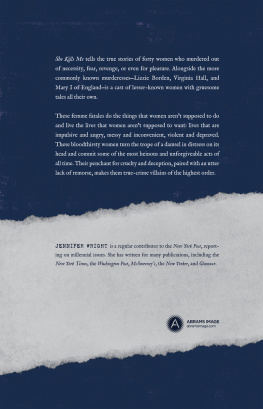
Pretty Evil
NEW ENGLAND
Pretty Evil
NEW ENGLAND
TRUE STORIES OF VIOLENT VIXENS AND MURDEROUS MATRIARCHS
SUE COLETTA

GUILFORD, CONNECTICUT

An imprint of The Rowman & Littlefield Publishing Group, Inc.
4501 Forbes Blvd., Ste. 200
Lanham, MD 20706
www.rowman.com
Distributed by NATIONAL BOOK NETWORK
Copyright 2020 by Sue Coletta
All rights reserved. No part of this book may be reproduced in any form or by any electronic or mechanical means, including information storage and retrieval systems, without written permission from the publisher, except by a reviewer who may quote passages in a review.
British Library Cataloguing in Publication Information available
Library of Congress Cataloging-in-Publication Data
Names: Coletta, Sue, 1967- author.
Title: Pretty evil New England : true stories of violent vixens and murderous matriarchs / Sue Coletta.
Description: Guilford, Connecticut : Globe Pequot, [2020] | Summary: Nineteenth century New England was the hunting ground of five female serial killers: Jane Toppan, Lydia Sherman, Nellie Webb, Harriet E. Nason, and Sarah Jane Robinson. In Pretty Evil New England, true crime author Sue Coletta tells the story of these five women, from broken childhoods, to first brushes with death, and she examines the overwhelming urges that propelled these women to take the lives of a combined total of more than one-hundred innocent victims. The murders, investigations, trials, and ultimate verdicts will stun and surprise readersProvided by publisher.
Identifiers: LCCN 2020026162 (print) | LCCN 2020026163 (ebook) | ISBN 9781493052332 (paperback ; alk. paper) | ISBN 9781493052349 (epub)
Subjects: LCSH: MurderNew EnglandCase studies. | Women murderersNew EnglandCase studies.
Classification: LCC HV6533.N22 C65 2020 (print) | LCC HV6533.N22 (ebook) | DDC 364.152/3092520974dc23
LC record available at https://lccn.loc.gov/2020026162
LC ebook record available at https://lccn.loc.gov/2020026163
 The paper used in this publication meets the minimum requirements of American National Standard for Information SciencesPermanence of Paper for Printed Library Materials, ANSI/NISO Z39.48-1992
The paper used in this publication meets the minimum requirements of American National Standard for Information SciencesPermanence of Paper for Printed Library Materials, ANSI/NISO Z39.48-1992
To honor the victims and their families, I offer a poem by New England native Edgar Allan Poe.
A Dream
In visions of the dark night
I have dreamed of joy departed
But a waking dream of life and light
Hath left me broken-hearted.
Ah! what is not a dream by day
To him whose eyes are cast
On things around him with a ray
Turned back upon the past?
That holy dreamthat holy dream,
While all the world were chiding,
Hath cheered me as a lovely beam
A lonely spirit guiding.
What though that light, thro storm and night,
So trembled from afar
What could there be more purely bright
In Truths day-star?

UNKNOWINGLY TEMPTING FATE
I n 1887, thirty-six-year-old Amelia Phinney survived the surgery for a uterine ulcer in Cambridge Hospital, a procedure done via cauterization with nitrate of silveronly to come face-to-face with New Englands most prolific female serial killer, whose body count reached well into the double digits. Post-op the following evening, Amelia tossed and turned on the cot in her room, the abdominal pain so severe it prevented her from falling asleep.
A shadowy figure emerged through the golden smolder of a bedside oil lamp. The dark-haired, dark-eyed nurse hovered over her bed with a peculiar intensity. When Amelia met her gaze, the stranger asked how she was feeling. The surgery, although successful, left her in a state of suffering. Amelia pleaded with the portly nurse to summon her doctor.
There is no need for that. The nurses voice remained soft, caring. I have something to make you feel better. Here. She slid her arm under Amelias shoulders and raised her far enough off the pillow to sip from the glass pressed to her lips. Drink this.
After swallowing a foul-tasting liquid, a numbness branched throughout Amelias torso and limbs. Her mouth and throat grew dry and scratchy, her eyelids weighted as she faded into a semi-conscious state. Someone pulled down the bedclothes. The cot creaked and the thin mattress sagged beneath the weight of a person climbing into bed with her.
The nurse cuddled and groped Amelia, stroking her hair, tenderly kissing her cheeks, forehead, and chin; her voice was soft, whispering that soon everything would be all right. Then the stranger rose to her knees. Hovering over Amelia, the nurse flipped Amelias eyelids inside-out and leaned ina determined stare, eye-to-eye.
Was this really happening?
The nurses breathing accelerated into a heavy pant. Hot breath pummeled the side of Amelias face as though her suffering excited the stranger.
Come, dear. The nurse pressed the glass to Amelias bottom lip again, urging her to swallow more of the bitter medicine. Drink just a little more.
Unwilling to obey, Amelia clamped her mouth closed and rolled her face to the opposite side of her pillow like a petulant toddler refusing to eat vegetables. Wooden clogs pattering down the hall outside the room startled the nurse, and she leaped off the bed and bustled out the door.
The next morning, a trainee named McCutcheon shook Amelia awake. When she opened her eyes her stomach acid sloshed in protest, a queasiness rising to her throat. For several hours she fought through a drug-induced haze. Once shed regained her faculties, she thought it best not to share the story of the bizarre encounter from the night before. The incident was so crazy it must have been a bad dream; a nightmare brought on by the pain reliever.
Or had a mystical guardian angel saved her life?
It would take fourteen years for her to discover the truth.

According to FBI behaviorists, the best way to survive a male serial killers attack is to let him get to know you on a personal level. By humanizing yourself, youll ruin his fantasy of you as a victim.
This wont work with a female serial killer. They already know you.

Another scorching summer day, another unexplained death.
In 1901 on Cape Cod, seagulls squawked over the catch of the day in fishermens nets, osprey nested along marshlands and sandy beaches, waves lapping against miles and miles of shorelines on the eastern, western, and southern tips of the Massachusetts peninsula, where horse-drawn carriages kicked up sorrel dust clouds, iron-shoed hooves clomping against pressed-gravel streets. Salt scented the air for miles. But by August 15 of that year, something evil veiled the peaceful seaside community of Cataumet.
Jane Toppan vacationed in the area for the first time in 1897. As a trained nurse and Cambridge Hospital graduate, Jane looked the part in every line of her face, every curve of her ample figure, every movement and mannerism. At that time she stayed at the Davis cottage with the prominent family of L.W. Ferdinand of Cambridge, next door to a rambling seasonal hotel called Jachin House. Guests from the city would congregate on Jachin Houses wide wrap-around porches to relax, rocking away the evening hours, cooled off by crisp ocean breezes sweeping in from Buzzards Bay.
Next page














 The paper used in this publication meets the minimum requirements of American National Standard for Information SciencesPermanence of Paper for Printed Library Materials, ANSI/NISO Z39.48-1992
The paper used in this publication meets the minimum requirements of American National Standard for Information SciencesPermanence of Paper for Printed Library Materials, ANSI/NISO Z39.48-1992

